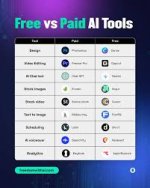The siren song of "free AI" is captivating in our increasingly digital world. We're bombarded with tools promising effortless content creation, instant answers, and automated workflows, all without a hefty price tag. But like any seemingly costless offering, the promise of free AI comes with a hidden ledger, and the bill, in the long run, might be far steeper than we anticipate.
Perhaps a more accurate title would be: "The Hidden Costs of Free AI: Beyond the Monetary Transaction." This shift in language immediately signals that the expense isn't always about dollars and cents. Instead, it delves into the more nuanced and potentially more significant sacrifices we make when embracing these seemingly benevolent technologies.
The most immediate "cost" often overlooked is our data. These free AI tools, whether they're generating text, crafting images, or analyzing our queries, learn and improve by processing vast amounts of information. And where does that information come from? Often, it's the very data we feed into them – our prompts, our shared files, our browsing history. While privacy policies may outline data usage, the sheer volume and complexity of this data collection raise concerns about how our information is being stored, analyzed, and potentially used to further refine the AI models, often in ways we don't fully understand or control. This isn't a direct monetary transaction, but it's a valuable commodity nonetheless, fueling the growth and influence of these AI providers.
Beyond our personal data, "free AI" can subtly erode our skills and critical thinking. When we rely on AI to generate our first drafts, summarize complex information, or even brainstorm ideas, we risk becoming passive recipients rather than active creators. The mental muscle of writing, analysis, and problem-solving can atrophy with disuse. The ease of AI-generated content might lead to a decline in our ability to articulate our own thoughts effectively and to engage in deep, critical analysis. This is a cost measured not in currency, but in the potential diminishment of human intellect and creativity.
Furthermore, the widespread adoption of "free AI" can contribute to the homogenization of content and thought. If numerous individuals rely on the same underlying models, the output, while seemingly diverse, might share underlying biases and limitations. This can lead to a less nuanced and less original digital landscape, where unique perspectives are overshadowed by the algorithmic average. The cost here is the richness and diversity of human expression.
The promise of democratized access through free AI also carries the potential for increased dependence and vendor lock-in. Once individuals and businesses become deeply integrated with a particular free AI ecosystem, switching to alternatives, even paid ones with better features or ethical practices, can become increasingly difficult and costly in terms of time and effort. This creates a power dynamic where the providers of "free" services wield significant influence.
Finally, the environmental cost of "free AI" cannot be ignored. Training and running these large language models and image generators require immense computational power, leading to significant energy consumption and a substantial carbon footprint. While the end-user might not directly pay for this electricity, the environmental consequences are a collective cost that future generations will bear.
In conclusion, while the allure of free AI is strong, we must look beyond the zero-dollar price tag. The true cost lies in the potential erosion of our privacy, the weakening of our cognitive abilities, the homogenization of thought, the risk of dependence, and the environmental impact. Recognizing these hidden costs is crucial for a more informed and responsible engagement with these powerful technologies. Perhaps, instead of blindly embracing the "free," we should prioritize understanding the true exchange and consider investing in AI solutions that value transparency, user control, and sustainable practices, even if they come with a monetary cost. The long-term benefits of such an approach might ultimately prove to be far more valuable than the fleeting illusion of something truly free.
Perhaps a more accurate title would be: "The Hidden Costs of Free AI: Beyond the Monetary Transaction." This shift in language immediately signals that the expense isn't always about dollars and cents. Instead, it delves into the more nuanced and potentially more significant sacrifices we make when embracing these seemingly benevolent technologies.
The most immediate "cost" often overlooked is our data. These free AI tools, whether they're generating text, crafting images, or analyzing our queries, learn and improve by processing vast amounts of information. And where does that information come from? Often, it's the very data we feed into them – our prompts, our shared files, our browsing history. While privacy policies may outline data usage, the sheer volume and complexity of this data collection raise concerns about how our information is being stored, analyzed, and potentially used to further refine the AI models, often in ways we don't fully understand or control. This isn't a direct monetary transaction, but it's a valuable commodity nonetheless, fueling the growth and influence of these AI providers.
Beyond our personal data, "free AI" can subtly erode our skills and critical thinking. When we rely on AI to generate our first drafts, summarize complex information, or even brainstorm ideas, we risk becoming passive recipients rather than active creators. The mental muscle of writing, analysis, and problem-solving can atrophy with disuse. The ease of AI-generated content might lead to a decline in our ability to articulate our own thoughts effectively and to engage in deep, critical analysis. This is a cost measured not in currency, but in the potential diminishment of human intellect and creativity.
Furthermore, the widespread adoption of "free AI" can contribute to the homogenization of content and thought. If numerous individuals rely on the same underlying models, the output, while seemingly diverse, might share underlying biases and limitations. This can lead to a less nuanced and less original digital landscape, where unique perspectives are overshadowed by the algorithmic average. The cost here is the richness and diversity of human expression.
The promise of democratized access through free AI also carries the potential for increased dependence and vendor lock-in. Once individuals and businesses become deeply integrated with a particular free AI ecosystem, switching to alternatives, even paid ones with better features or ethical practices, can become increasingly difficult and costly in terms of time and effort. This creates a power dynamic where the providers of "free" services wield significant influence.
Finally, the environmental cost of "free AI" cannot be ignored. Training and running these large language models and image generators require immense computational power, leading to significant energy consumption and a substantial carbon footprint. While the end-user might not directly pay for this electricity, the environmental consequences are a collective cost that future generations will bear.
In conclusion, while the allure of free AI is strong, we must look beyond the zero-dollar price tag. The true cost lies in the potential erosion of our privacy, the weakening of our cognitive abilities, the homogenization of thought, the risk of dependence, and the environmental impact. Recognizing these hidden costs is crucial for a more informed and responsible engagement with these powerful technologies. Perhaps, instead of blindly embracing the "free," we should prioritize understanding the true exchange and consider investing in AI solutions that value transparency, user control, and sustainable practices, even if they come with a monetary cost. The long-term benefits of such an approach might ultimately prove to be far more valuable than the fleeting illusion of something truly free.


